How To See Like A Bird
This lab is developing new methods to visualize the unseen spectrum of bird plumage.
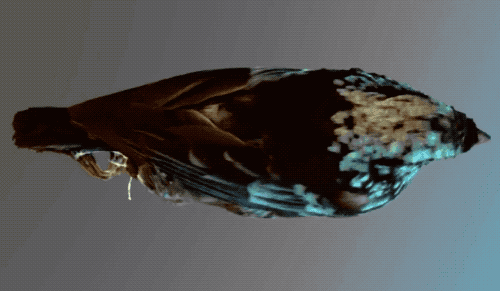
 This story is part of our summer Book Club conversation about Jennifer Ackerman’s book ‘The Genius of Birds.’ Want to participate? Sign up for our newsletter or send us your thoughts on the SciFri VoxPop app.
This story is part of our summer Book Club conversation about Jennifer Ackerman’s book ‘The Genius of Birds.’ Want to participate? Sign up for our newsletter or send us your thoughts on the SciFri VoxPop app.
At first glance, the plumage of the beryl-spangled tanager might appear a subtle pale blue. But viewed at a different angle, the South American songbird glimmers an electric turquoise with glints of gold. This color-transforming phenomenon is known as iridescence.
“I’ve seen a lot of really beautiful birds in beautiful images, but I realized that taking pictures you miss out on this really very eerie phenomenon,” says Joshua Medina, a 3D artist and specializing in digitization at the Moore Lab of Zoology at Occidental College in Los Angeles. “And that’s something that you can only replicate in a three-dimensional model.”
The Moore Lab is a trove of more than 65,000 bird specimens mostly collected in Mexico and South America from 1933 to 1955. As a technical artist, Medina develops 3D models so people can see the colors, patterns, and tricky visual cues in bird plumage, which can be difficult to visualize for study.
“It’s like having the specimen there right in front of you,” says John McCormack, director and curator of birds and mammals at the Moore Lab. “You can get up-close and see the bird even in more detail than if you were looking at it with the naked eye.”
Moore Lab Tanagers (and a guest, orange-fronted parakeet) created by Joshua Medina and the Moore Lab on Sketchfab.
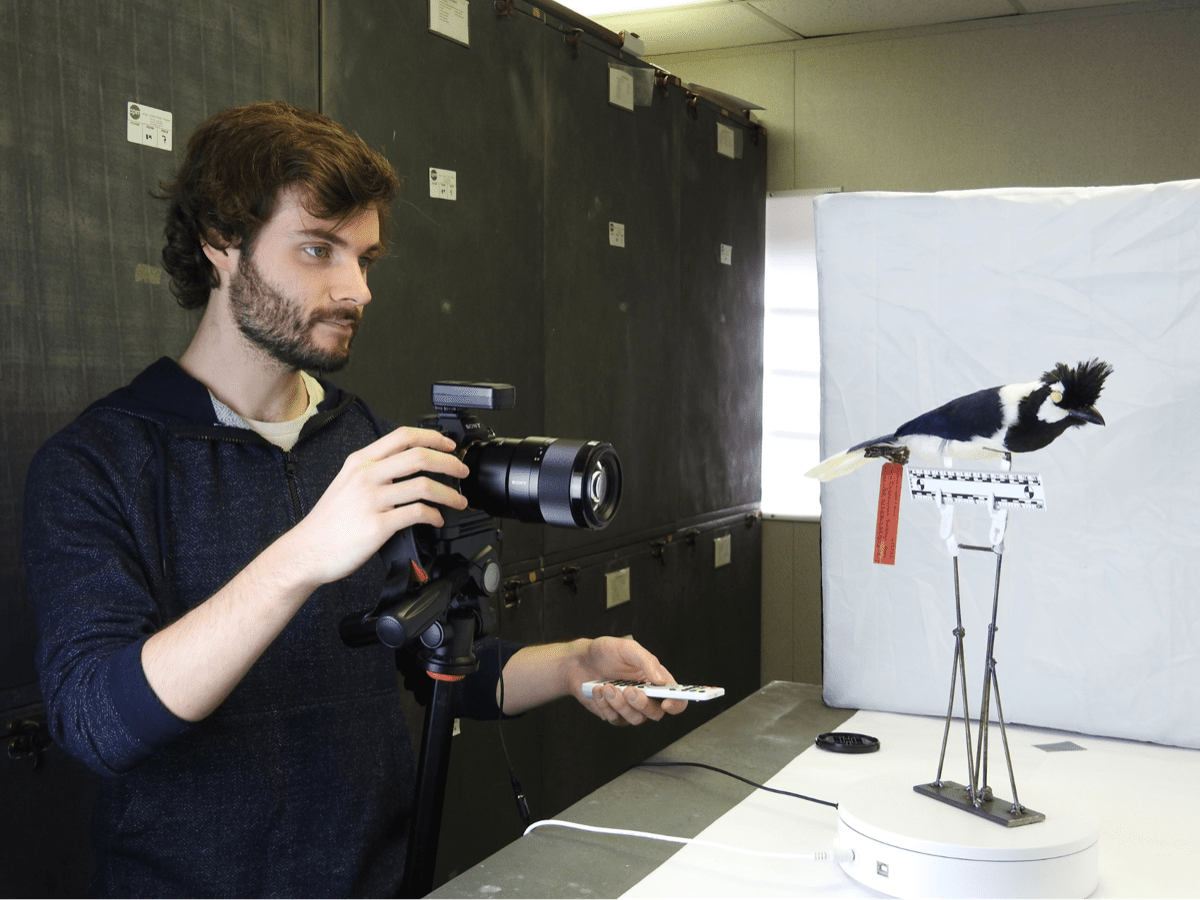
Medina uses a 3D technique called photogrammetry. His initial setup as an undergraduate was in his dorm, using a turntable with a stuffed bird specimen and a number of desk lamps. (“People walking in must have thought it looked very eerie.”) Manually “DJing” the table, he would take hundreds of digital photos from various angles as the bird rotated. He’s since ditched the DJing and the dorm room, and transitioned into a fully automated turntable that spins the bird with every click of the camera. A single model can comprise of up to 288 photos from three different angles, processed by home-brewed open-source programs.
“It’s pretty wild,” says McCormack. “You can take that 3D model and you can essentially unzip it and flatten it into a square basically that includes every single pixel-sized piece on the whole model.” A researcher could then extract and analyze every single color found on a bird specimen, which could be helpful in tracing the evolution of plumage colors in different bird species.

Swatches of various scanned tanager species, which the Moore Lab uses for plumage color analysis. Left to right (click for high-resolution): beryl-spangled tanager, spotted tanager, golden-hooded tanager. Credit: Joshua Medina/The Moore Lab
Birds have colors for many different reasons. Ruddy, mottled brown plumage could camouflage a bird from predators, while a lighter colored plumage might help cool birds off. Flamboyant colors like the iridescent plumage on the throats of hummingbirds might be a showy advertisement for mates.
“These are sometimes incredibly intricate displays with all kinds of colors and patterns that a female bird typically is seeing and processing and making decisions about mating,” says McCormack. “This gets into bird intelligence.”
Vision is a bird’s most important sense, McCormack explains, and to process large amounts of visual information, birds have big optical lobes.
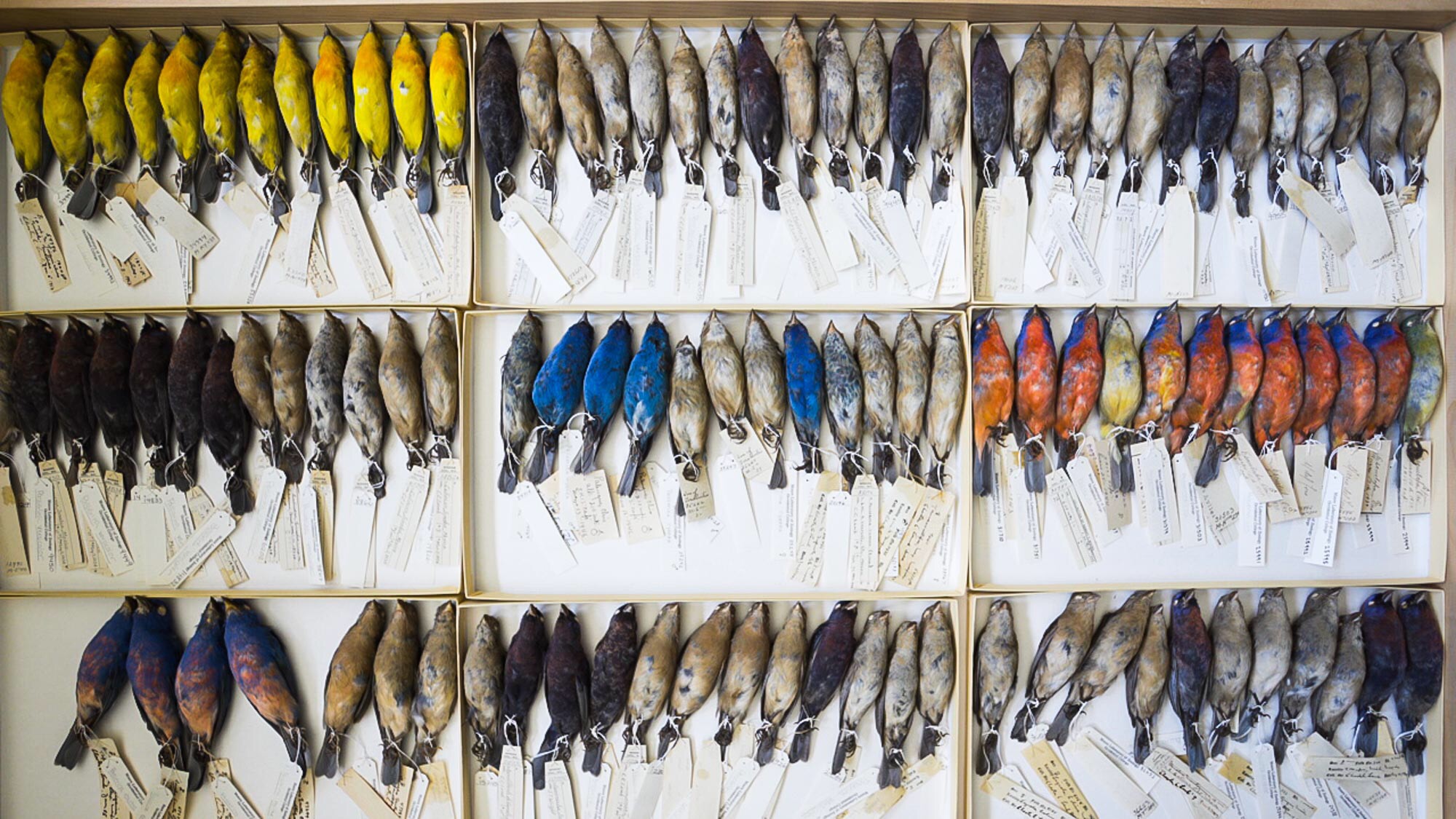
Assorted species of buntings in the genus Passerina showing both colorful males and brown females in the Moore Lab bird collection. Credit: John McCormack/The Moore Lab
“Just about 20 years ago, it became pretty well-known that birds are seeing differently than we do,” says Allison Shultz, assistant curator of ornithology at the Natural History Museum of Los Angeles County, currently studying the plumage of tanagers. “They have a kind of enhanced vision compared to us.”
To process colors, humans have three types of cones cones in their eyes, explains Shultz, or photoreceptors that are sensitive to red, green, and blue. But birds have four cones—the fourth cone extending their sight beyond our visual spectrum. While humans see colors in wavelengths of 400 to 700 nanometers, birds dip into part of the ultraviolet spectrum, seeing 300 to 700 nanometers.
“Birds can see some ultraviolet colors that we can’t even describe,” says McCormack. “We don’t even know what those colors are. We don’t have words for them because we’ll never see them, but birds see them.”
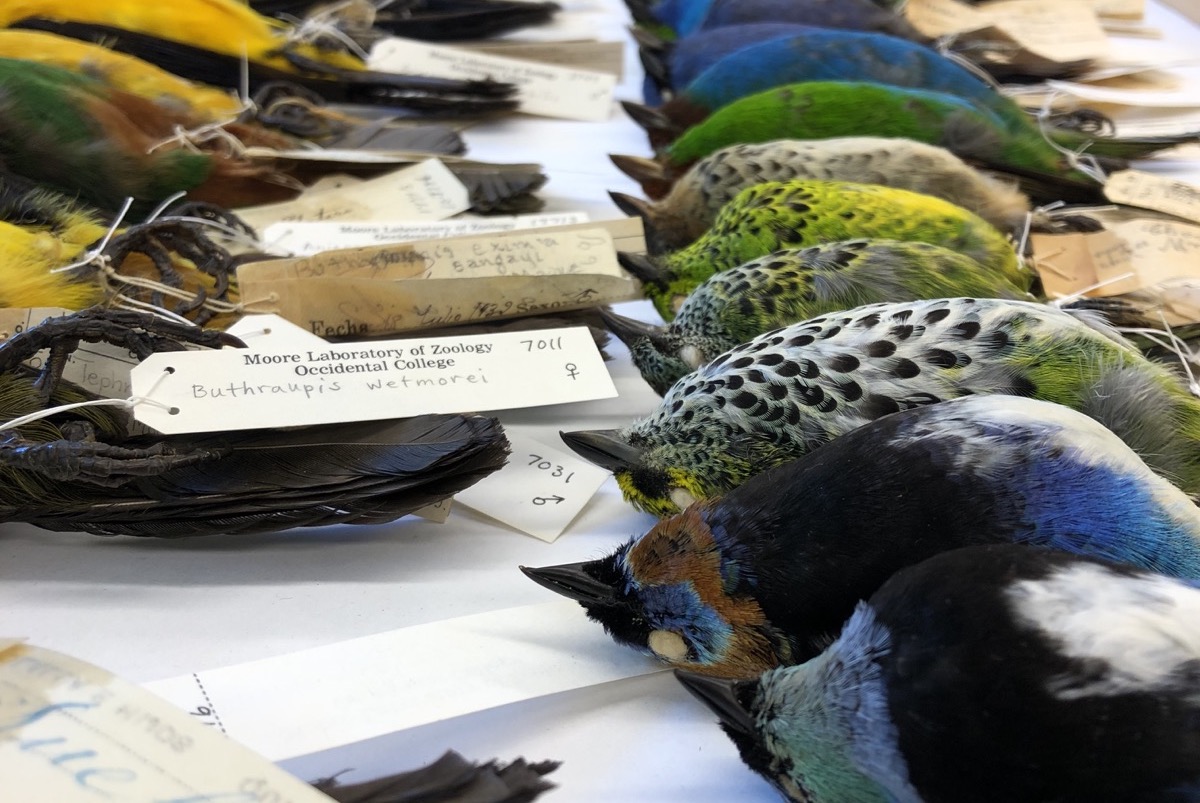
Various species of tanagers, a Central and South American songbird, preserved at the Moore Lab. Credit: John McCormack/The Moore Lab
Not only do birds have more types of cones than humans, but their cone cells are precise color filters. Each of them have little oil droplets that restrict the amount of light that hits each individual cone, which allows birds to distinguish differences between similar colors that go unnoticed by the human eye, says Shultz.
Tanagers, a family of species that live throughout Central and South America, for example, span almost the entire color spectrum seen in birds, says Shultz. Researchers originally thought that 50% of the approximately 370 species were dichromatic, where males and females have different plumage colors. However, when Shultz and her colleague Kevin Burns measured the colors from an avian vision model, they estimated that the tanagers are actually 93% dichromatic.
“There’s a lot of variation that we are missing with our eyes,” Shultz says.
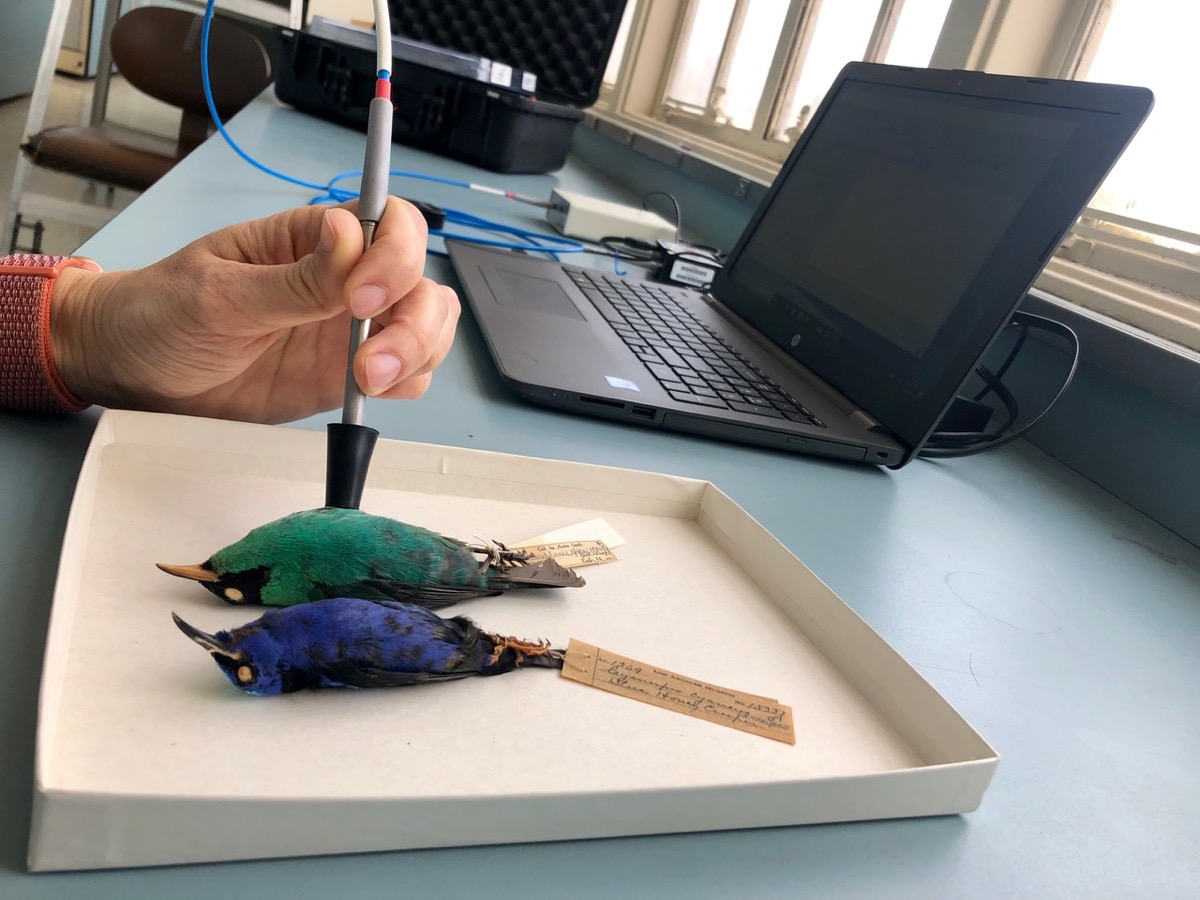
Shultz and McCormack are devising ways for researchers to be able to see what birds see. Current techniques require a reflectance spectrophotometer, a device that uses a fiber optic probe that sends pulses of xenon light—light that encompasses the entire spectrum—on an object. The light that is reflected back tells researchers what colors are present in a bird’s plumage, including features of the bird only visible in the ultraviolet spectrum. “The reflectance spectrophotometry is great. We can then apply the model of avian vision to those data, but it really is points on a bird,” says Shultz—but the point-precision capturing of the probe misses larger patches of patterns.
That’s why Shultz, McCormack, and Medina are working on getting a UV camera set up. “Being able to use the Moore Lab’s technique with a UV camera as well as a digital camera to give us a sense of a bird’s patterning in a 3D space will be really important,” Shultz says.
Currently, all of the Moore Lab specimens are cataloged online, but only a few are photographed and some valuable species can’t be removed from the lab. The team is streamlining the process to digitize the entire collection in 3D, so researchers all around the world can access and interact with bird specimens. People will not only be able to closely analyze color, but they can examine texture, transparency, and reflective surfaces, Medina says.
“What’s interesting is that each one of these layers is most often presented just as data in the science and in the digitizing,” he says. “But I think when you visualize that data, it becomes something that’s much more tangibly artistic and interesting.”
Special thanks to Joshua Medina and the Moore Lab for sharing and generating supplemental 3D visuals. Explore more 3D bird models from the Moore Lab collections on Medina’s Sketchfab.
Invest in quality science journalism by making a donation to Science Friday.
Lauren J. Young was Science Friday’s digital producer. When she’s not shelving books as a library assistant, she’s adding to her impressive Pez dispenser collection.